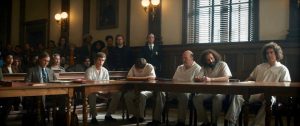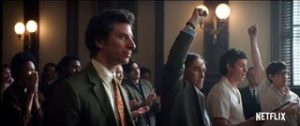The Trial of the Chicago 7

We thought a citation for contempt had to be preceded by a warning?
(Directed by Aaron Sorkin) (2020) (Netflix)
Ah, Hollywood. They’ve been dreaming-up stories of white hats vs black hats since the days of Tom Mix. In this rather ho-hum court room film, there are plenty of black hats to go around: John Mitchell, vindictive Nixon Attorney-General, who wants a Show Trial of the Yippies: His sundry henchmen from the Justice Department; Chicago Mayor Richard Daley and his police goons; Chicago undercover cops who infiltrate the activist groups and in some cases shamelessly tempt them; Judge Julius Hoffman (played by that all-purpose villain of the legislative, executive and judicial branches of government, Frank Langella); the enthusiastic purveyors of the Vietnam War.
Setting a film around a trial is a convenient organizational ploy: it lets you flash-back, flash-forward and flash-sideways, and a trial’s adversarial nature keeps you in tune with the white and black hats, even when you forget (or don’t care) who is whom.
The really interesting story was the lead-up to the confrontations at the 1968 Democratic Convention in ‘Fort Daley’ (a year, like ours now, graced with the unreliable rubric “unprecedented”), involving endless political permutations, jockeying, threats of violence and rebellion, and the cataclysm of LBJ’s decision not to seek re-election, but the film skirts all that, possibly because it wants to avoid showing the insurgents’ sizeable chunk of blame for the resulting shambles*, albeit less than Daley’s over-the-top, stupid, brutal, almost berserk police force.
The peace-in-Vietnam activist groups descending on Chicago that summer included the Yippees, led by Abbie Hoffman (no relation to the judge; described thus in An American Melodrama – “With his long, curly black tresses and sharp, intelligent face he looks rather like a Semitic Charles I”), and Jerry Rubin; David Dellinger (Quaker and head of ‘National Mobilization’), his lieutenants Rennie Davis and Tom Hayden; some minor ‘conspirators’ (Lee Weiner and John Froines); and the founder and head of the Black Panthers, Bobby Seale (who was there by accident, gagged and bound by the Judge and removed during the proceedings, turning the Chicago 8 into the Chicago 7). We don’t learn a hell of a lot about any of them, and we certainly don’t find ourselves on the edge of our seats fearing for them: they’re here to be monstered by the black hats, and absolved in the closing credits.
As for the trial itself, starting as a circus in the autumn of 1969 and ending as an obsequy several seasons later, it is mostly a series of snappy vignettes; snappy glances and grins, bon mots, gavel-banging by the frustrated and impotent old judge. The defendants range from suited Quaker, to clean-cut organizer (a crypto-Obama, if you will) to goofy hippys, and a real terrorist. Their inter-action is strictly by the numbers however, as are the performances by the attorneys for both sides (Mark Rylance doing his version of Thomas Cromwell in a cheap suit), plus Sacha Baron Cohen playing a dramatic role in a comedic way. Eddie Redmayne, as Hayden, comes across like an earnest, worried sufferer in an antiperspirant commercial. Michael Keaton appears in a cabaret turn as Ramsey Clark. The whole melange fails to satisfy, persuade, or inform. At the end, we shared the contempt both Hoffmans felt and showed throughout.
Footnote
[* There were in fact a number of calls that might be characterized as amounting to incitement. For example, Bobby Seale called on Chicago demonstrators to “go barbecue some pork….pick up a crowbar. Pick up a piece. Pick up a gun…If you shoot well, all I’m gonna do is pat you on the back and say ‘Keep shooting.’ You dig?” Jerry Rubin held formal seminars on the construction of Molotov cocktails. Hayden spoke from Paris in the middle of the year of a revolutionary takeover of Chicago. During the drama of the convention, someone raised a Vietcong flag. After Rennie Davis was beaten to a pulp by police, Hayden called on the crowd: “Let us make sure that if blood is going to flow, let it flow all over this city.” (He forgot to say “our” before “blood”, according to the film.) Fires were lit in Lincoln Park and Grant Park. In Playing With Fire, Lawrence O’Donnell observed (p.346): “The protestors kept raising the rhetorical stakes. They informed Daley’s office that three hundred thousand protestors would arrive in Chicago even though they expected less than a hundred thousand. Rumors flew of plans to put LSD in the Chicago water supply, attack the convention hall, and trash high-priced stores on the Loop. “The North Vietnamese are shedding blood,” Tom Hayden said. “We must be prepared to shed [our?] blood.” MOBE assembled a raft of protest marshals to teach protestors not only how to resist passively but also how to fight back if necessary, and how to break through police lines.”]Leave a comment...
While your email address is required to post a comment, it will NOT be published.




0 Comments